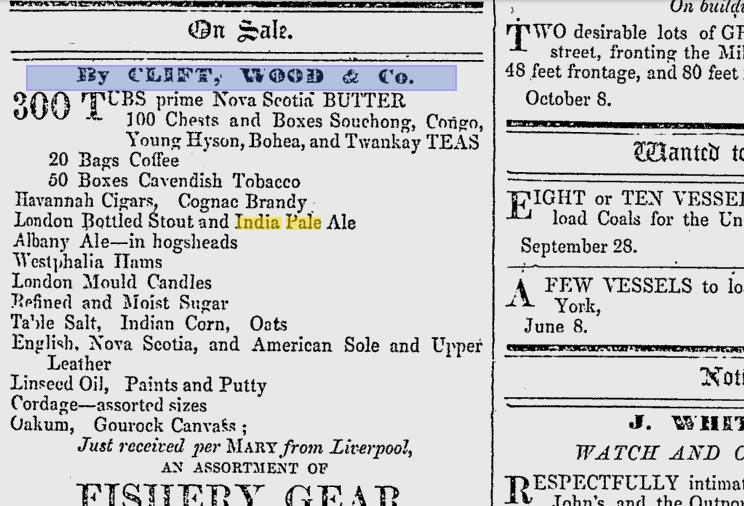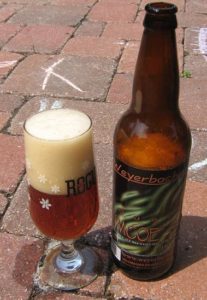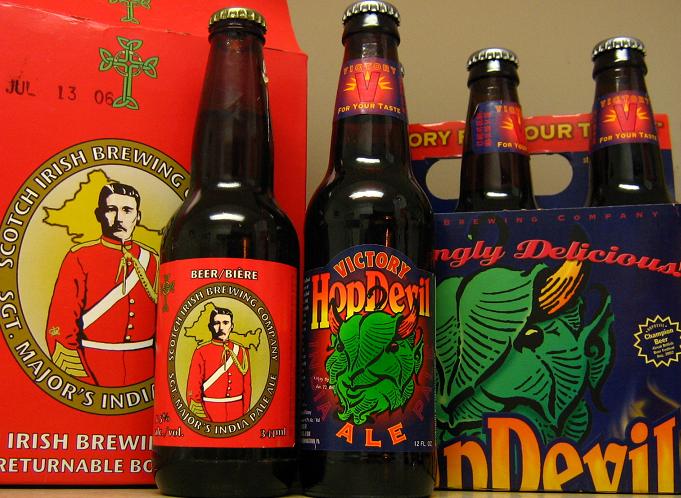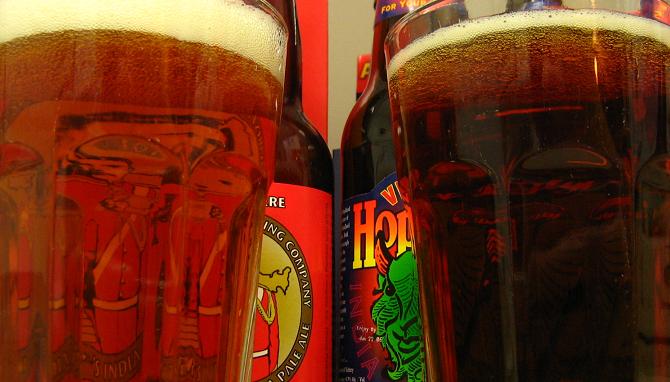
PA’s Tröegs Hopback, southwest NY’s Southern Tier,
Ithaca’s Flower Power and Maine’s Shipyard.
Porter lost out to India Pale Ale somewhere in the mid-1800s. The style came out of the export trade to the British soldiers in the Empire – by brewing double strength and double hopped, the ale travelled better and was expected to be diluted when it got there. Plan B was rapidly brought into play. In the revival of beer making that has occurred over the last twenty years, big hops and big body have been something of a flagship for each brewer. Sometimes it works and sometimes it doesn’t. These suds are all in the game. You’ve seen the Ithacan before but now it is with compadres.
As an aside, this is something that has not taken off in Canada in the same way. If there is a great hopped ale it is more in the English style like the excellent Propeller ESB out of Halifax. The micro-micro brewery at Rogue’s Roost also in Halifax made small batches of wonderful IPAs but they were not a hit with the crowd and ended up dry-hopped in corny kegs (ie soda pop canisters) for the select crowd of Lorne’s pals. I have not had a micro in Ontario that went anywhere near where either Nova Scotian went – even they are “IPA lite” compared to any number of available brews from below the border. Can enyone suggest a rival for these four?
Southern Tier IPA:This beer is not so complex as either the Ithaca or Tröegs examples but that is not necessarily a bad thing. At the end there is a bit of alcohol heat which is expected at 6.5%. Woodsy hopping feels more like Fuggles than Goldings but there is a bit of the orange peel of the latter as well. Not real green or minty, either. Spicy, however, and with the extra body it is not unlike or perhaps a good compliment to a Sussex Golden Ginger Ale. A bit heavy to be a session beer. The Beer Advocate reviews are positive and I will buy biscuity but I am not finding the hops grapefruity. That all does go to the problem of describing taste as no one is really wrong to a certain point. Located at the very south western corner of New York, the Southern Tier Brewery is a worthy new find for me.
Ithaca Flower Power IPA: I wrote about this one before but it is good to be a standard. In fact, of the ales tested, Ithaca Flower Power IPA and Brooklyn Brown are real winners so far. This time I am impressed by the balance of the Flower Power without recourse to a particularly heavy or heady body. The brewery tells us:
Available April 1 – September 31. Elegantly traditional and rich in its hop character, this India Pale Ale is thirst-quenching and soul-satisfying. Each sip delivers a bounty of herbal and floral hop character, balanced by the fruity signature of our house yeast. Cheers! This seasonal product is available only on draft, 1/4 bbl keg, or 1/2 bbl keg.
The website is a bit behind as I am clearly drinking a bottle. The lads at the Beer Advocate think it may be a session beer but that would be like eating arugula all evening instead of dill pickle chips. I like this opinion:
It kind of sneaks up on you, through the easy going, crunchy, jam band listening feel. The oak is very distinct, meeting a walnut yeast flavor and balancing biscuity grain. A lingering woody hop flavor, with a bit of grainy malt sticking to the back of the tongue. Medium bodied, with soft but steady carbonation. A bit of a rough-hewn mouthfeel, with all the earth, wood and grain going on.
I like it. A very earthy, natural feel. The graininess is somewhat like an organic ale, and the oak flavor really conjures up a cask feel. It’s a nice enough IPA, but perhaps a little more bite would make it better. Some of that herbal, piney oiliness. Regardless, I like the woody, earthy feel, it creates character and makes the brew distinct.That is it! Arugula. The beer has that bit of black pepper zing with vegetative green in the hops that is like the green aka roquette. Damn good beer.
Tröegs Hopback Amber Ale: far left, this beer is pretty fine, a notch above medium body, a fresh hops profile, fairly sweet from crystal malts with a light citrus edge through it. The brewer says:
Tröegs HopBack Amber gets its unique name and taste from the HopBack Vessel in our brewhouse. Packed full of whole flavor hops, each batch circulates through the vessel, creating a fresh hoppy aroma, spicy taste and rich caramel note that defines this signature amber ale.
It is rich, mellow, satisfying and quite morish and the Beer advoates approve. It is not as molar janglingly hopped as other pale ales or IPAs US brewers will throw at you but sometimes the hopping can go too far if you are looking for something to have more than one bottle of. At 6% it is not a session beer but you could fool yourself despite the warming. Like the other ales I have been happy with, the challenge they place on the Canadian bigotry against US brews is definitely on.
Shipyard IPA: I have a sectret that is no secret and that is I love Shipyard’s ales. I have crawled all over the brewery on a ad hoc tour by the brew master one Saturday with portland at Portland. I have t-shirts and a ball cap. I have (briefly) abandoned my family on visits immediately upon dropping them off at the home being visited to rush to DiPietro’s around the corner – the great pizza maker, beer and wine store, corner grocery of South Portland – to pick up a captain’s case, the variety packs US micro-brewers put out of three bottles of four styles that make such sense. It sums up much of what is great about Maine – quality, tradition and independence. (In fact, the current polling in Maine giving Bush the lead give me the expectation that Kerry will win nationally…they go their own way to that degree.)
At the brewery I was stunned to find open top modern square fermenters, like found at the excellent Samuel Smith’s brewery of Yorkshire, England. Ale fans and even Ale-fan will know that the open square is a form of fermentation that requires the yeast head to effectively seal the fluid forming in to beer below it. No gauges and pipes up top, just a burbling crops of foam. That foam replicates itself when the bottle purs into a big rocky head that leaves a venerous lightly beiged lace on the glass as it settles. It is very mich alive. It also, again like sherry, arguably allows for a certain respiration, which when your Brewery is by the seashore in Casco Bay, can be argued to add a sea saltiness aspect to the brew – sort of like certain Islay malts.
The brew itself [Ed.: click on IPA on the java-ed frame] is fruity and fuggley which makes it fairly close to the orange juice of ales. The beer used to be called Fuggles IPA according to one of my t-shirts and is fairly brave in its selection of a single hop. Fuggles is the oldest variety of hops still used and has a twiggy edge not present in the more noble hops like Goldings with its fine candy cane, citrus characteristics. The website uses the word spicy but that is a little general in the sense that I like to use that word for either Christmas pudding flavours you can get in darks or peppery nutmegy clovey flavours you can get in hefeweissens. At 5.8%, there is a little bit of heat to Shipyard IPA there but it is well-framed in the hops and medium bodied malt. The beer advocatonians are mixed on this brew, 13% giving it a thumbs down for the properties that the square fermenation and use of Fuggles actually intends. They are not a mistakes so much as decisions. I also have noted that Shipyard’s flagship Export had been described as a Canadian ale in some quarters. The grainy roughness of the brews certainly is familiar to me in that regard. Consider this review:
Certainly bitter, though so many IPAs are made with one of the hops that starts with a “C” that this one seems unique despite its blandness. Well carbonated and lively, it’s certainly refreshing. Bits of lemon and berry tart drizzled in caramel. But then it’s really just hops. You get the hint of complexity, but dry, grainy, hop oily intensity takes over. Hops is the word of the day. They’re all over the backend of this beer. No harshness or alcohol to slow consumption. Goes down well.
In a sense this beer is a pinnacle of former glory Maritime brewing style which I grew up with out of the Olands and Moosehead breweries. It is like the beer Oland’s Export might be were it brewed as a real ale rather than a beer replicant containing mainly corn sugar and irish moss. If I were Mike in Halifax, I would load up a rental van with non-drinkers, drive the eight hours to the brewery, buy their share of the border crossing allowance with taxes paid and have a very happy winter.
There you have it. All my USA summer brews are extinguished, supped, downed and the reviews are complete. Good thing I have a week off after Canadian Thanksgiving and am planning a day trip two hours south to the Galeville Grocery and even perhaps the Party Source in Syracuse.
 As recently discussed, the past is a foreign land when it comes to US beer history. More like another planet it seems sometimes. I am not sure why this is but I suspect it has something to do with the drive to be authoritative rather than innovative when it comes to so many of the beer books being published. Sadly, there is more than enough problematic high level description of various qualities out there but far too little of the more interesting and accurate detail.
As recently discussed, the past is a foreign land when it comes to US beer history. More like another planet it seems sometimes. I am not sure why this is but I suspect it has something to do with the drive to be authoritative rather than innovative when it comes to so many of the beer books being published. Sadly, there is more than enough problematic high level description of various qualities out there but far too little of the more interesting and accurate detail.






